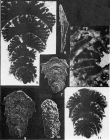Foraminifera taxon details
Pavonitina Schubert, 1914 †
737943 (urn:lsid:marinespecies.org:taxname:737943)
accepted
Genus
Pavonitina styriaca Schubert, 1914 † (type by original designation)
Phyllopsammia Małecki, 1954 † · unaccepted (Subjective junior synonym in...)
Subjective junior synonym in opinion of Loeblich and Tappan (1987)
- Species Pavonitina adanula (Małecki, 1954) †
- Species Pavonitina biarritzensis Sztrákos, 1987 †
- Species Pavonitina hispanica Sztrákos, 1987 †
- Species Pavonitina kiscelliana (Sztrákos, 1979) †
- Species Pavonitina plana Loeblich & Tappan, 1985 †
- Species Pavonitina styriaca Schubert, 1914 †
- Species Pavonitina tirolensis Loeblich & Tappan, 1985 †
marine, brackish, fresh, terrestrial
fossil only
feminine
Schubert, R. J. (1914). <i>Pavonitina styriaca</i>, eine neue Foraminifere aus dem mittelsteirischen Schlier. <em>Jahrbuch der kaiserlich-königlichen geologischen Reichsanstalt.</em> 64(1-2):143-148., available online at https://biodiversitylibrary.org/page/35705440
page(s): p. 143 [details]
page(s): p. 143 [details]
Hayward, B.W.; Le Coze, F.; Vachard, D.; Gross, O. (2024). World Foraminifera Database. Pavonitina Schubert, 1914 †. Accessed at: https://marinespecies.org/foraminifera/aphia.php?p=taxdetails&id=737943 on 2024-05-02
Date
action
by
original description
Schubert, R. J. (1914). <i>Pavonitina styriaca</i>, eine neue Foraminifere aus dem mittelsteirischen Schlier. <em>Jahrbuch der kaiserlich-königlichen geologischen Reichsanstalt.</em> 64(1-2):143-148., available online at https://biodiversitylibrary.org/page/35705440
page(s): p. 143 [details]
original description (of Phyllopsammia Małecki, 1954 †) Małecki, J. (1954). O nowych rodzajach otwornic aglutynujących z polskiego miocenu - New genera of agglutinated foraminifera from the Polish Miocene. <em>Annales Societatis Geologorum Poloniae Polish Geological Society.</em> 22(4): 497-513., available online at https://geojournals.pgi.gov.pl/asgp/article/view/10559/9051
page(s): p. 503, 507, 511 [details] Available for editors [request]
[request]
page(s): p. 143 [details]
original description (of Phyllopsammia Małecki, 1954 †) Małecki, J. (1954). O nowych rodzajach otwornic aglutynujących z polskiego miocenu - New genera of agglutinated foraminifera from the Polish Miocene. <em>Annales Societatis Geologorum Poloniae Polish Geological Society.</em> 22(4): 497-513., available online at https://geojournals.pgi.gov.pl/asgp/article/view/10559/9051
page(s): p. 503, 507, 511 [details] Available for editors
From editor or global species database
Diagnosis Test of medium to large size, broad and flattened, spherical proloculus followed by biserial stage of up to eight pairs of broad and low chambers that curve back at the outer margins, the biserial stage being followed by broad low and centrally arched uniserial rectilinear chambers, interior of later biserial and uniserial chambers subdivided by secondary septula that project obliquely downward from the chamber roof; wall finely agglutinated, thin and fragile, noncanaliculate; aperture interiomarginal in the biserial stage, single and terminal in the uniserial stage. L. Oligocene to Miocene; France; Poland; Austria; Yugoslavia; Africa: offshore Cabinda (Angola). (Loeblich & Tappan, 1987, Foraminiferal Genera and Their Classification) [details]
